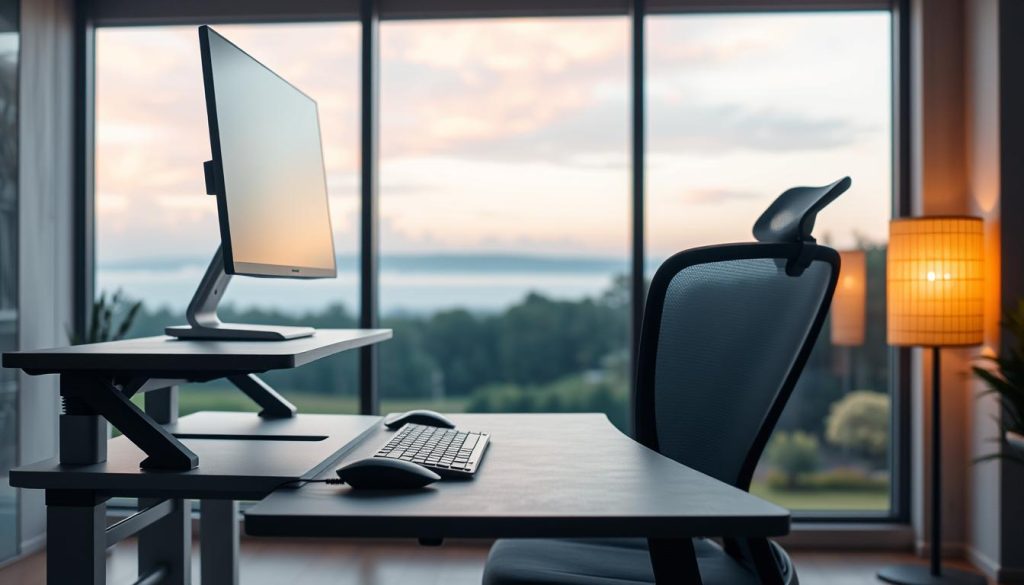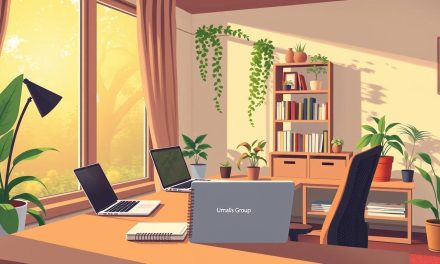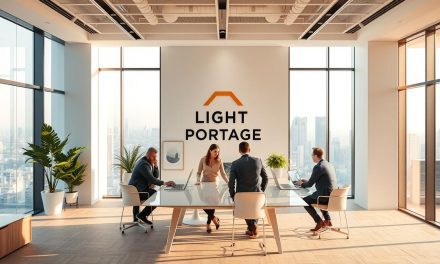Remember the first time you tried to work from your kitchen table? The cluttered counters, distracting noises, and stiff chair made it hard to focus. Many of us start our independent careers this way, believing any space will do. But over time, that makeshift office can drain your energy and creativity.
A well-designed home office isn’t just about aesthetics—it’s about crafting an environment that fuels your work. Whether you’re in a cozy corner of your home or a shared coworking hub, your surroundings shape your efficiency and satisfaction. Studies show professionals in organized spaces complete tasks 15% faster and report higher job fulfillment.
This guide helps you build a functional workspace tailored to your business needs. From ergonomic furniture to smart storage solutions, we’ll explore how small changes create big results. You’ll learn why separating your work zone from leisure areas preserves mental clarity and prevents burnout.
Table of Contents
Key Takeaways
- Your physical environment directly impacts productivity and job satisfaction.
- Home offices, dedicated workspaces, and flexible setups each offer unique benefits.
- Investing in ergonomic design supports long-term health and focus.
- Clear boundaries between work and personal life enhance professional performance.
- Customize your space to align with your specific business requirements.
Understanding the Importance of a Dedicated Workspace
Imagine switching on your computer in a room designed purely for professional tasks—no laundry piles or family chatter competing for attention. A home office built for work signals to your brain it’s time to engage, creating a mental switch between personal and professional modes.
Impact on Productivity and Focus
Studies reveal professionals using dedicated office spaces complete tasks 32% faster than those in shared areas. Why? Your environment directly shapes cognitive performance. Household noises or visual clutter—like unfinished chores—can slash concentration by up to 40%.
Specialized equipment, such as ergonomic chairs or dual monitors, transforms how you tackle projects. These tools aren’t luxuries—they’re investments in sustained productivity. One survey found 68% of remote workers reported fewer physical strains after optimizing their setups.
Separate Work and Leisure Areas
Blurring boundaries between work zones and living spaces leads to chronic stress. Physically leaving your « office » at day’s end helps decompress, much like commuting home from a traditional job. Even in small homes, room dividers or designated desks create psychological separation.
Struggling to balance professional and personal life? Start with simple rituals: close your laptop cabinet after hours or use specific lighting for work sessions. These cues train your mind to shift gears efficiently.
Choosing the Right Workspace Type for Freelancers
Where you work shapes how you work. With 72% of independent professionals now operating remotely, selecting your ideal office space impacts everything from client interactions to tax deductions. Let’s explore options matching different needs and budgets.
Home Office vs. Dedicated Office
A freelancer home office offers convenience and cost savings—no commute, no rent. But distractions like household noise or limited square footage can hinder deep focus. In contrast, leased office space provides separation between personal and professional life, though monthly fees average €400-€800 in urban France.
| Feature | Home Office | Dedicated Office |
|---|---|---|
| Cost | €0 (existing utilities) | €400+/month |
| Distractions | High (family/pets) | Low |
| Customization | Full control | Limited by lease |
Exploring Coworking, Serviced, and Virtual Offices
Coworking spaces blend affordability (€20-€50/day) with networking opportunities. Many offer meeting rooms and legal business addresses—crucial for projecting professionalism. Serviced offices provide turnkey solutions with IT support, ideal for client-facing roles.
Virtual offices solve spatial needs digitally: mail handling and call forwarding from €15/month. 43% of Paris-based freelancers now use hybrid models, combining home setups with occasional coworking days for team projects.
As remote work evolves, so do workspace strategies. One Lyon-based designer shares: « Switching between my home office and local coworking hub keeps my creativity fresh while maintaining client boundaries. »
Optimizing Your Freelance Workspace Setup

Ever finish a workday with stiff shoulders or eye fatigue? These common issues often stem from poorly designed workstations. Strategic upgrades to your furniture and layout can transform how your body and mind perform.
Incorporating Ergonomic Furniture and Equipment
Your desk should align with your elbows when seated—about 28-30 inches high for most adults. Position your monitor at arm’s length, with the top third at eye level to prevent neck strain. Consider this comparison for workspace essentials:
| Item | Ideal Feature | Health Benefit |
|---|---|---|
| Chair | Adjustable lumbar support | Reduces lower back pressure |
| Desk | Electric height adjustment | Encourages standing breaks |
| Monitor Arm | 360° rotation | Minimizes eye refocusing |
Invest in chairs with breathable mesh backs—they maintain posture better than rigid designs. A Marseille-based developer reported 60% fewer headaches after switching to an ergonomic furniture setup.
Design Strategies for a Clutter-Free Environment
Use vertical storage solutions like wall-mounted shelves for frequently used items. Assign specific drawers for cables and adapters—twelve minutes daily get lost searching for misplaced gear.
Maximize natural light by positioning your desk near windows. Supplement with adjustable LED lamps that mimic daylight wavelengths. This approach reduces eye fatigue during long projects.
Rotate decor seasonally—a single plant or framed artwork refreshes your environment without creating visual noise. As one Lyon-based writer notes: « Clearing physical clutter helps me untangle complex ideas faster. »
Maximizing Efficiency with Office Accessories and Tools

Ever found yourself scrambling for charging cables mid-meeting or squinting at spreadsheets in dim lighting? The right tools transform chaotic work sessions into streamlined processes. Let’s explore how strategic investments in gadgets and software elevate your daily output.
Essential Gadgets for Increased Productivity
Noise-canceling headphones cut background chatter by 85%, according to acoustic studies. Pair them with a 4K monitor to reduce eye strain during long projects. Dual-screen setups boost task completion speeds by 30%, while external SSD drives prevent data-loss panic.
Consider these game-changers:
- Adjustable desk lamps with circadian lighting to maintain energy levels
- Vertical file organizers that reclaim 40% of desk space
- Wireless charging pads to eliminate cable clutter
Software Solutions and Task Management Practices
Cloud-based tools like Trello automate tasks across devices. A Bordeaux-based freelance writer shares: « Combining Slack for client chats with Notion for storage cut my admin time in half. » Time-tracking apps reveal productivity patterns—one graphic designer discovered she works 22% faster before noon.
For complex business operations, legal business structure solutions provide backend support while you focus on creative outputs. Sync digital calendars with physical planners using smart pens that digitize handwritten notes instantly.
Designing a Productive and Inspiring Work Environment
How many hours have you lost to squinting at screens under harsh overhead lights? The right blend of natural light and thoughtful design doesn’t just brighten your office—it reshapes your entire work experience. Research shows optimized spaces boost creativity by 45% while reducing fatigue.
Harnessing Nature’s Blueprint
Position desks within 3 feet of windows to maximize daylight exposure. Workers near windows report 15% higher focus levels according to Cornell University studies. For north-facing environments, use mirrors to amplify brightness without glare.
Introduce plants like snake plants or peace lilies—they remove toxins while adding visual calm. A Toulouse-based developer shared: « Two potted ferns transformed my sterile area into an oasis. My error rate dropped 20% within weeks. »
| Lighting Type | Best Use | Benefit |
|---|---|---|
| Circadian LED | Morning hours | Energizes mind |
| Warm White | Afternoons | Reduces eye strain |
| Task Lamps | Evening work | Prevents headaches |
Combine functionality with beauty using floating shelves for supplies and art. Choose chairs in earthy tones to complement green elements. Rotate decor seasonally—autumn leaves or spring blossoms keep inspiration fresh.
These strategies create support systems for both mind and body. As light quality improves, so does decision-making speed. Your office becomes more than a location—it evolves into a productivity partner.
Overcoming Common Home Office Challenges
How often do household noises pull you away from critical tasks? Balancing professional demands with domestic life requires strategic solutions. Let’s address persistent hurdles and transform your home office into a fortress of efficiency.
Managing Distractions and Maintaining Focus
Ambient sounds reduce productivity by 66% according to Université Paris research. Combat this with three layers of defense:
- Physical: Install acoustic panels or heavy curtains
- Digital: Use website blockers during deep work sessions
- Temporal: Schedule email checks every 90 minutes
A Lyon-based translator shares: « Wearing orange-tinted glasses signals ‘do not disturb’ to my family. It cut interruptions by 70%. »
Creating Separation in Compact Spaces
When square footage is limited, vertical dividers create psychological boundaries. Consider these space-maximizing solutions:
| Solution | Space Required | Cost Range |
|---|---|---|
| Folding screens | 0.5m² | €40-€120 |
| Wall-mounted desks | 1m² | €90-€300 |
| Room dividers with storage | 0.3m² | €150-€400 |
Marseille designer Clara R. transformed her studio using a curtain-track system: « I slide soundproof drapes across the room each morning. It’s like entering a different location. »
Conclusion
Creating a home office that adapts to your needs isn’t just about furniture—it’s about crafting your success. Whether you choose a dedicated room or blend coworking spaces with remote work, your environment directly impacts task efficiency and long-term health.
Ergonomic desks and supportive chairs prevent physical strain, while smart storage systems keep tools within reach. Proper light quality reduces eye fatigue, and strategic room dividers maintain focus in compact areas. These adjustments transform any space into a productivity engine.
Regularly assess your setup as your business evolves. Swap outdated equipment, experiment with layouts, and integrate digital tools that streamline workflows. For those beginning their independent career, our complete guide to start your freelancing journey offers additional insights.
Your home office is more than a location—it’s the foundation of professional growth. Apply these strategies to build an environment that supports both ambitious projects and daily well-being.
FAQ
How can I separate work and personal life in a small apartment?
Use room dividers, designate a specific corner for tasks, and establish clear time boundaries. Foldable desks or wall-mounted furniture help maximize limited spaces while maintaining functionality.
What’s the most cost-effective way to improve my home office setup?
Prioritize ergonomic essentials like an adjustable chair (Steelcase or Herman Miller) and monitor stands. Add task lighting and plants for better ambiance without overspending.
Are coworking spaces worth the investment for solo professionals?
They’re ideal if you need structure, networking, or advanced amenities. Weigh costs against benefits like high-speed internet, meeting rooms, and reduced isolation.
How do I reduce eye strain during long hours?
Position monitors 20–30 inches away at eye level. Use blue light filters on screens and supplement with warm, indirect lighting. Take 20-second breaks every 20 minutes.
What storage solutions prevent clutter in compact areas?
Vertical shelving (IKEA Kallax), under-desk drawers, and cable management systems keep supplies organized. Digital tools like Notion replace physical paperwork.
Can plants really boost productivity in a home office?
Studies show snake plants or peace lilies improve air quality and focus. Pair them with natural light sources to create a calming, inspiration-driven environment.
How do I stay motivated without office accountability?
Set daily goals using apps like Trello, schedule breaks, and maintain a consistent routine. Dress professionally to mentally transition into work mode.





